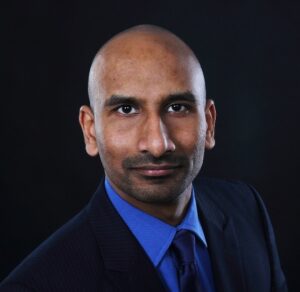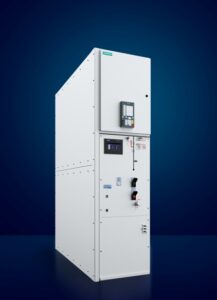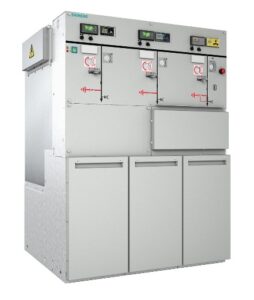Sulphur hexafluoride (SF6) gas is a very popular insulating medium and has been the bedrock of gas insulated switchgear (GIS) for over four decades. Today, the world is getting increasingly conscious of the high global warming potential (GWP) of SF6 that is now recognized as a greenhouse gas. In this engagement, we have Dr. Karthik Reddy Venna, Product Lifecycle Manager – Gas Insulated Switchgears & Sustainability, Siemens Smart Infrastructure, discussing the role of SF6 in GIS and how Siemens is taking the global lead in developing innovative switchgear technologies, completely devoid of SF6, under what is known as Siemens’ “Blue Portfolio”. An interaction by Venugopal Pillai.

What specific properties of SF6 have made it so popular in gas-insulated switchgear (GIS)? On the other hand, what is the potential damage that SF6 leakage from GIS can cause?
SF6 gas is one of the best dielectric insulating medium available on the market today. The gas exhibits stable behavior throughout its lifetime. The last 40 years of industrial experience and usage shows that it is a reliable insulating medium. However, it is crucial to note that SF6, despite its significance, is the most powerful greenhouse gas discovered so far. In terms of its ability to capture infrared radiation, SF6 is 24,300 times more efficient than an equal quantity of carbon dioxide (CO2) over a 100-year span.
Moreover, SF6 exhibits exceptional stability as a chemical compound, with a lifespan of 3,200 years in the atmosphere. When released, SF6 remains virtually unchanged for many centuries, accumulating in the atmosphere without degradation.
Consequently, even a small quantity of SF6 can exert a substantial influence on global climate change.
As alternatives to SF6, we understand that Siemens is using a combination of vacuum interruption technology and “clean air” in its “Blue Portfolio”. Tell us more.
 Vacuum interruption technology is a well-established method for interrupting electrical currents in circuit breakers. It involves creating a vacuum environment within the circuit breaker, which prevents electrical arcing and extinguishes the current. This technology has been widely used and proven effective in various applications. “Clean Air” is used instead of SF6 to provide the necessary insulation and dielectric properties.
Vacuum interruption technology is a well-established method for interrupting electrical currents in circuit breakers. It involves creating a vacuum environment within the circuit breaker, which prevents electrical arcing and extinguishes the current. This technology has been widely used and proven effective in various applications. “Clean Air” is used instead of SF6 to provide the necessary insulation and dielectric properties.
“Clean Air” typically refers to a mixture of natural-origin gases like N2, CO2 and O2, which are naturally occurring gases in the earth’s atmosphere. These gases have a significantly lower global warming potential of <1 compared to SF6, making them more environmentally friendly. “Clean Air” does not require specialized handling, monitoring, or disposal procedures like SF6, which can incur additional expenses. Furthermore, the availability and affordability of natural-origin gases make “Clean Air” a cost-effective alternative in the long run. Many countries and international organizations have implemented regulations and guidelines to reduce SF6 emissions due to its high GWP (global warming potential).
By using “Clean Air,” organizations can comply with these regulations and contribute to their sustainability goals. It allows companies to align their practices with evolving environmental standards.
Siemens very recently introduced SF6-free Clean Air based GIS with a rating of 40.5kV. Please discuss the significance of this product.
We are very proud to introduce the 8DAB 40 gas-insulated switchgear as a part of our sustainable blue GIS portfolio. It is a single busbar switchgear for primary distribution networks up to 40.5kV, 2,500 and 40kA ratings. It uses “Clean Air” as insulating medium which consists of natural-origin gases with GWP < 1. The 8DAB 40 is designed based on one of our most successful switchgear, the 8DA/B platform, which ensures all the benefits of traditional gas insulated switchgear such as high reliability and operational safety, while keeping the exact same footprint as todays SF6 switchgear. Due to its eco efficiency design this switchgear has the lowest possible CO2 footprint today at its voltage level. Additionally, the 8DAB 40 integrates state-of-the-art sensor techniques, making it digital and intelligent.
The developed world has pledged to eliminate SF6 from GIS in a time-bound and phased manner. In your assessment, by when would it be practically possible for GIS to be SF6-free?
At Siemens, a company with sustainability at its heart, we are implementing all possible methods to reduce the CO2 footprint of our products. We have already launched and delivered SF6-free GIS up to 40.5kV level in primary distribution and in parallel are developing the SF6-free version for secondary distribution level. We are confident that we will comply with the EU F-Gas regulation deadlines to eliminate SF6.
We also understand that companies are working on SF6 alternatives like fluorinitrile-based gas mixtures. What is your take on the matter? Would this alternative be still in the domain of F-gases?
At the medium voltage level, there are various SF6 alternatives being discussed. They are fluoronitrile-based gas mixtures, fluoroketone-based gas mixtures – both chemical based alternatives – and natural origin-based mixtures that Siemens is using.
We believe that when moving away from SF6 gas, it is the time to come up with the best alternative, not just for environmental betterment but also one that is safe and clean to use. Both above-mentioned chemical alternatives are PFAS substances and various literature shows detrimental effects on human health when exposed to them. Moreover, there are many switchgear companies in the MV range that have come up with switchgear with natural origin gases as alternatives.
Please describe the various products developed so far under Siemens’ Blue Portfolio. What additions can we expect in the medium term?
 We have a wide range of products for both primary and secondary distribution networks. At the primary distribution level, we have the “8DAB 12”, “NXPLUS C 24” and now the “8DAB 40” covering voltage ranges up to the 40,5kV level.
We have a wide range of products for both primary and secondary distribution networks. At the primary distribution level, we have the “8DAB 12”, “NXPLUS C 24” and now the “8DAB 40” covering voltage ranges up to the 40,5kV level.
In secondary distribution, we have the “8DJH 12” and “8DJH 24” covering up to the 24kV level. For our secondary GIS, we have created an innovative blue switch where the load currents are interrupted in the vacuum interrupter that is placed in the auxiliary path. This is one of the finest examples of Siemens’ innovative solutions.
In addition, we have developed SIBushing which will replace conventional instrument transformers such as current transformers and voltage transformers. SIBushing has an integrated Rogowski Coil and capacitive voltage divider to measure both current and voltage respectively. This will save a lot of material and provide sustainable and reliable operation of the switchgear. We are also working on blue GIS at secondary distribution level for 36 kV, which can be expected in the midterm.
Can we presume that vacuum interruption technology using “clean air” would be the basis for the Blue Portfolio? Are more alternatives being studied?
As of now, we are focusing only on vacuum interrupter and “Clean Air” as a basis for our blue GIS portfolio. No other alternatives are currently being investigated.
Siemens has planned to become completely SF6-free by 2030. How do you see the progress so far?
We are in a good position to achieve our target of having a complete portfolio with SF6 free technologies within the regulated timeframes.


